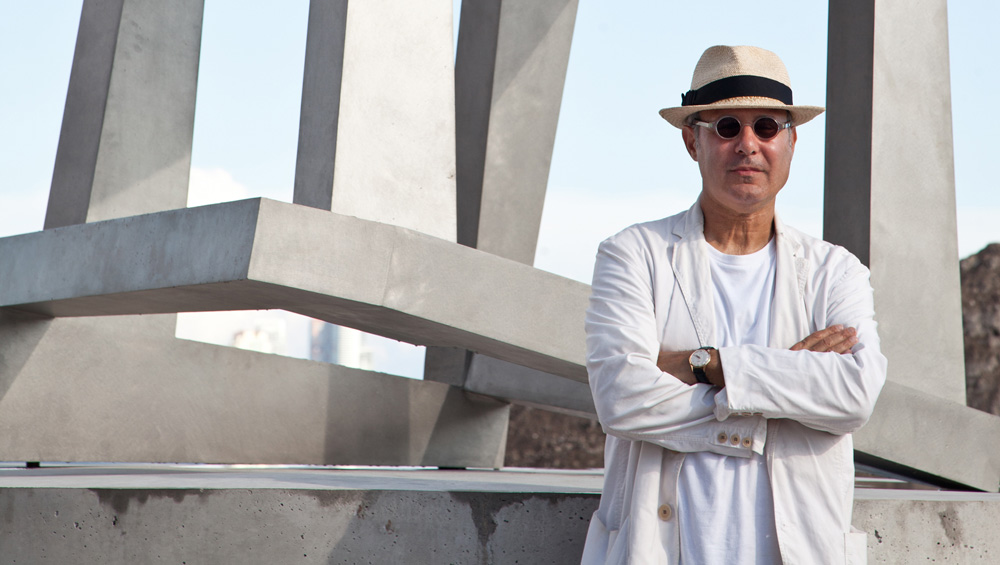
by VERONICA SIMPSON
Jedd Novatt was born in New York in 1958 and raised there, so it is perhaps no surprise that his sculptures appear to be attempting to explode or escape from the grid. Where that city, with its towering “canyon” typology is a monumental parade of glass, steel and concrete solidity, his Chaos series endlessly seeks to articulate “the weight and volume of space”. Now, Novatt is based between his home and studio in Paris, a home in Provence and the foundry and sculpture studio of Alfa Arte, in Eibar (about 50km from Bilbao), and his muscular, monumental structures are prominent in civic, gallery and institutional settings all around the globe, from Bilbao to the Napa Valley.
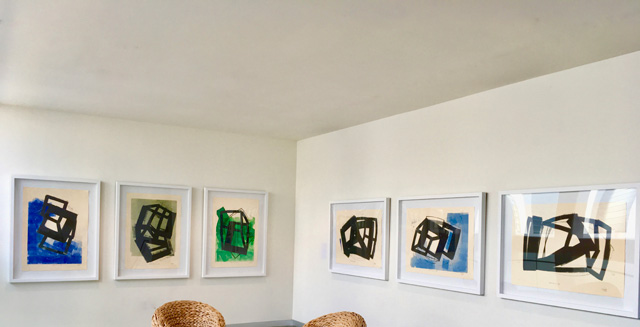
Jedd Novatt. Monotypes, Savannah College of Art and Design (SCAD) Museum of Art.
Novatt first studied literature and sculpture at Sarah Lawrence College, Bronxville, New York, then travelled to France, to further his studies in sculpture at the Lacoste School of the Arts. He returned to New York in 1981 and took on a studio in Tribeca. His first solo exhibition in New York was at the Tibor de Nagy Gallery. In 2002, he moved to Paris. He has participated in many group exhibitions and had multiple solo exhibitions all over the world - the US, the UK, Belgium, France, the Netherlands, Italy, Singapore and Spain. Last year, Chaos Pacific, Monotypes, showed at Savannah College of Art and Design (SCAD) Museum of Art. Since 2008, he has participated five times in Beyond Limits, Sotheby’s annual selling exhibition at Chatsworth House, Derbyshire.
.jpg)
Jedd Novatt. Chaos Meteoro, 2012. Bronze, 530 x 427 x 307 cm. Chatsworth House Trust, Derbyshire, UK.
In 2015, Chatsworth acquired one of his works, Chaos Meteoro, for its permanent collection, joining a large number of significant galleries and institutions that have acquired and incorporated his work into their landscapes, including SCAD Museum of Art, Georgia (Chaos Mundaka 2009); the town of Yountville, Napa Valley (Chaos Pamplona, 2011); and the city of Bilbao (Chaos Nervión, 2012).
He is represented by Waddington Custot, London. Studio International interviewed Novatt at his foundry in Eibar while he was preparing a number of new works in mild steel and Cor-Ten for an exhibition at Waddington Custot in November 2018.
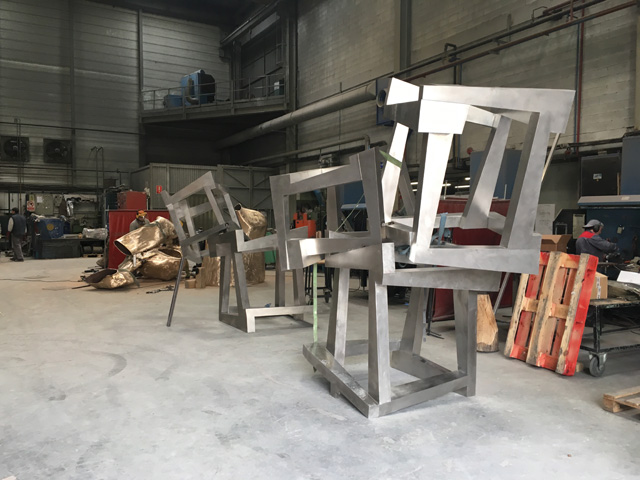
Jedd Novatt. New Chaos sculptures at Bilbao Foundry.
Veronica Simpson: The forthcoming show at Waddington Custot will feature new pieces from your Chaos series, which are being made here in Spain. You started work on this series in 1999 - nearly 20 years ago. What is it that keeps calling you back to it? Is it a process where you think you have addressed something in one piece and, in doing so, you are raising other questions?
Jedd Novatt: That’s exactly right. I think what’s interesting is you’re thinking about something and trying to deal with it and, all of a sudden, you realise you’ve completed a work. And it brings up 20 other questions you’re thinking about. I think when you create a series of works … When you think about Mark Rothko or go down the list - Richard Serra, Carl Andre or Frank Gehry, Eduardo Chillida - all these people whose work I do admire - I think you keep pushing ideas as hard as you can. And, by the way, it’s not about the idea of finishing something, or completing something. If I come back in 100 years, I could tell you – ah, yeah, this work did solve something. But I’ve no idea now. No artist does. That’s the absurdity of the idea that the artist is going to have some clue about their own work, and I know that I don’t. I just keep on making work. And so on with the next one, and the next one. In the end, this body of work will exist and in the future they’re going to have some way of deciding what it means, or how it fits or doesn’t fit, but it’s ultimately just a giant puzzle to me. At the end of the day, all the works I’ve created are part of that puzzle.
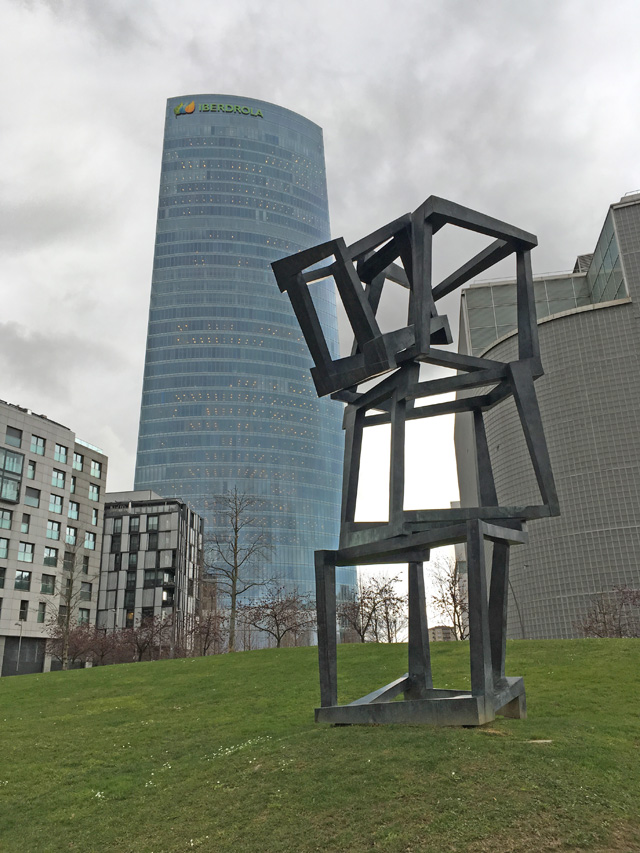
Jedd Novatt. Chaos Nervión, 2012, Bilbao, with the César Pelli Iberdrola Tower (left) and Rafael Moneo library (right). Bronze, 7.4 m.
VS: You said in an interview once that the placement of your work in cities or landscapes is part of the puzzle. How do you locate or identify the key elements of the puzzle in a site, in order to find the perfect location for your piece, for example, here in Bilbao?
JN: When you see the work in Bilbao between the Rafael Moneo library, the César Pelli Iberdrola Tower and the Frank Gehry Guggenheim, it’s right in the perfect spot. They worked with me a lot because I wanted it on a hill, so it’s not this flat thing. I wanted every dimension. But when I create a work, it has to be independently successful, regardless of where it goes. Then the idea of placing the work becomes very exciting because how you place the work will have a great effect on the work itself. But it’s secondary to this inherent success of the sculpture and yet that becomes primary to the success of the installation, so there’s a multitude of these elements that are very exciting.
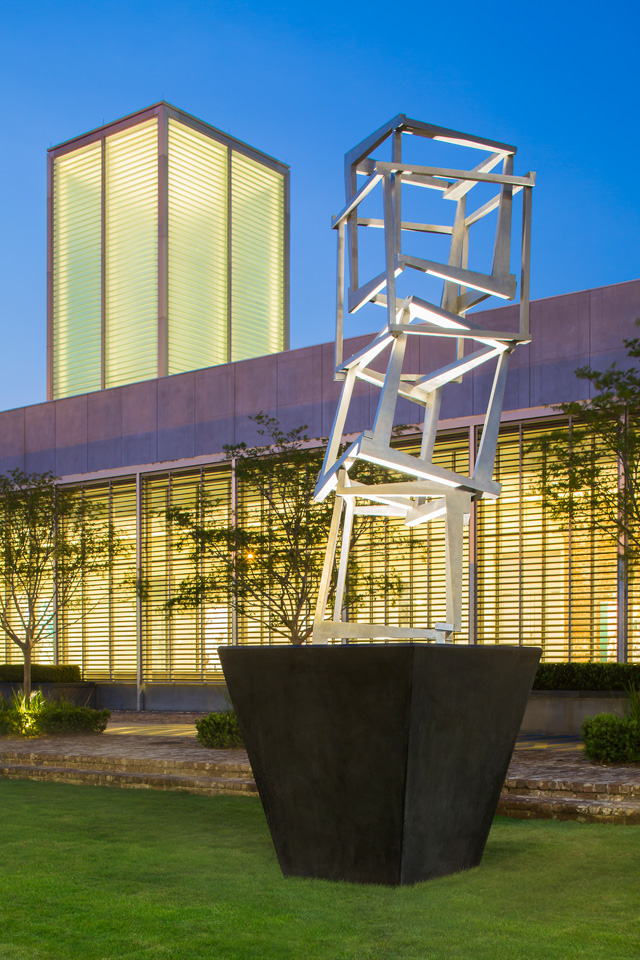
Jedd Novatt. Chaos Concepción, 2017, Savannah College of Art and Design (SCAD) Museum of Art, Savannah, Georgia, Stainless steel.
With sculpture, what you’re looking for is a very rigorous approach to a very formal exploration of space - whatever that means, and I think it’s infinite. This whole idea of chaos, for me, it became this idea of the random nature of things. When you create works, they are not at all random, but then they are, in the bigger scheme of it all. Because, let’s face it, we think we’re having some level of control of something, but we’re in control of nothing. That’s the great beauty of it. So, we take a specific environment where you place a work. You think you’re imposing your will somehow. But you’re not. You keep thinking you’re going to define something and yet it’s not definable. You think you’re going to complete something that’s not possible. I end up feeling it’s all completely infinite. And I like that.
When people discuss what makes work succeed, first and foremost we recognise that there’s this banal idea of subjectivity. I find it tiresome: does that mean that nothing is really good and nothing is really bad? That, to me, is really boring. Because there’s a reason that things seem to last - listening to the music of Handel or Bach, there’s a reason it lasts.
VS: Does it comes down to rigour?
JN: I think it does on some level. But it doesn’t mean that rigour is necessarily going to solve the problem. It can only lead to more questions.
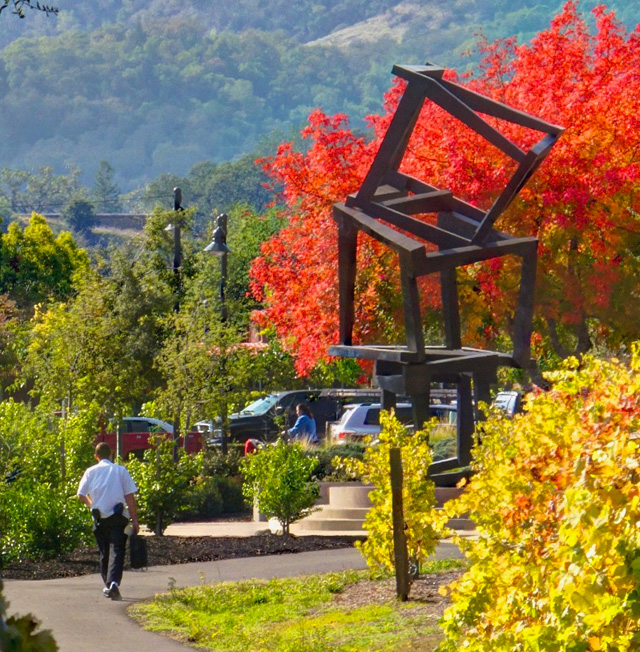
Jedd Novatt. Chaos Pamplona, 2011. Bronze, permanent installation, Yountville Napa Valley, California.
VS: Can you look back at your art school self and see traces of this fascination with rigour then?
JN: I certainly wasn’t conscious of it. I didn’t think about it. I think I thought about it later. You can look back on things later with a bit more clarity about the process, and I realise, yeah, I kept trying to push something as far as I could.
VS: When you set up your studio in Manhattan, you chose to work with scrap metal, presumably for economic reasons. And you have said that you liked the challenge of working with this very difficult, unmalleable material. In this way, you probably arrived at solutions you would never have discovered if you had been working with something less challenging.
JN: It’s a bit of a hunt. You have to figure out how do I get material, because you’ve got no money. And that’s hard. Then you go through this process of finding it, hauling it, dealing with it all, cutting it, grinding it.
VS: It wasn’t the found aesthetic that appealed to you?
JN: Not at all. I wanted to transform it. But also, you think about early criticism and I remember, when I was about 18, a professor of mine said something really important. He said: “You want to get beyond the industrial quality of the material, whatever that is.” And it was a crucial criticism as a student and young artist. Then, there was a comment from a guy called Dick Bellamy, who owned a gallery called Oil and Steel in New York – he was one of the great art dealers. I was about 23 when he visited my studio. And he said: “What’s really important is how do you arrive at the work being better than it is strong.” I thought about that a lot. How do you get beyond the industrial element of the material, and how do you make work that is not just strong, but good. These two ideas were principal for me in thinking about rigour.
VS: In describing architecture, we are always drawn to references to enclosures and clearings, to nature and landscape. With your work, you are evoking those references – rooms, towers or trees – but you are not providing what people expect. There are more questions than answers.
JN: I like the way you put that. In the end, you know, it’s about the weight and volume of space. That’s my primary interest: how do you end up on some level describing the weight and volume of space? When I look at my works, they end up not at all being about the physicality of the form.
Also, there’s this idea of repetition of form. You think about Donald Judd, and a number of artists who are about a repetition of form – also Andre - there’s an impact. Sculpture has impact. The impact of repetition has significance. In music, there is a certain impact with the repetition of a note. All of these things combine. In literature, there’s a repetition because the word “the” might be 40 times on the page. Always, there’s this repetition of a similar form, concept, shape and inevitably it leads to a certain sort of so-called balance: balance on a page, balance conceptually, balance physically. But that’s not what interests me. This idea of balance or precariousness, or the idea of some level of equilibrium people talk about (in describing his work), I reject it all. It’s out of my control.
VS: It’s not so much about balance as tension: there has to be an electricity or tension about the work in order to succeed. And that’s true of writing, painting or sculpture. Where that tension comes from, maybe that should remain mysterious.
JN: Absolutely. I think it should remain mysterious. It’s way beyond our understanding.
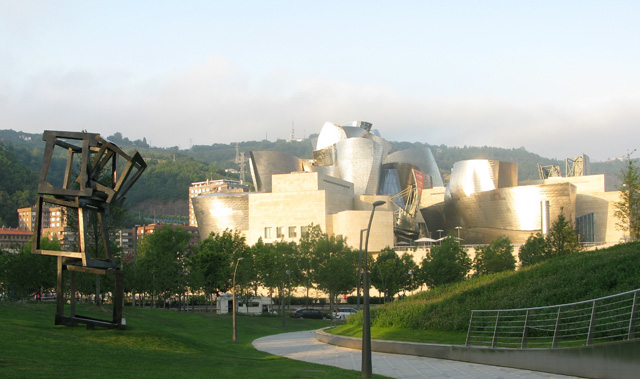
Jedd Novatt. Chaos Nervión, 2012. Bronze, 7.4 m. Bilbao.
VS: In looking at your sculpture here in Bilbao (Chaos Nervión, 2012), it seems that tension is very much present: there is a real, dynamic interplay between your angular sculpture and the dancing metal curves of the Guggenheim in the distance, or the smooth, shiny, receding planes of Pelli’s tower and the solid monumentality of Moneo’s library. They have done a lovely job with the arrangement of both the buildings and your sculpture here.
JN: I agree, it’s perfect. I think they really do care here. And I think that, again, this idea of incorporation of sculpture into architecture, a lot of it is just timing. So, when they chose my work for this particular spot, there was a spot apparently that Anthony Caro was very interested in creating a work for, but the timing wasn’t right as they hadn’t got to the point of developing this part of the site, so his work went somewhere else. So, some of it is just incredible, arbitrary elements - the fortuitousness of a moment. They’re trying to solve this puzzle of space and somehow your piece fits that puzzle for them.
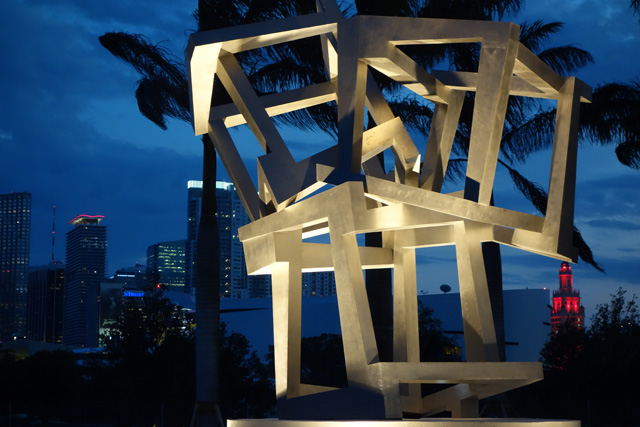
Jedd Novatt, Chaos SAS, 2013. Stainless steel, 440 x 420 x 265 cm. Permanent installation at Pérez Art Museum, Miami.
VS: Given the prevalence of this form in your work, when did the idea of working with the square or cube seize you?
JN: First off, it never seized me because it has nothing to do with it. In the early days, I created work and it was work that was much more complex, and I started to then almost chip away at it, strip it, strip it back, and then arrive at these cubic types of works. They’re not perfect. They’re the furthest thing from this perfect square. They’re more about the idea of trying to contain space, almost as … you think about a vessel that’s containing space … as weight, as volume, as a liquid form, or anything at all. That’s all I kept on doing. And finding that, within that space, there’s a torque and that torque creates a tension, and that tension creates another, and the one thing hits another, hits another thing. The use of the actual cubic shape is no different from a painter using some oil paint. It’s somewhat irrelevant to me. It’s what I get out of it - what ends up holding these shapes in a way where they don’t feel hollow. They become the opposite of hollow. How does space become the opposite of hollow?
VS: So, is it similar to the way that, say, Gehry keeps being drawn back to the curve – there is an excitement for him in breaking away from the grid that we are otherwise surrounded by. For you, the excitement is in exploring or exploding that grid?
JN: Yes, exploding, exploring and recognising to some degree do we start internally or externally? And what does that mean? In my case, I’m much more interested in the internal, you know. I’d say what’s the internal friction that’s being created? What I use is just a tool to get there. When I get there, I feel it, and it makes sense to me. When you see this piece (in Bilbao), you can go up inside it. You start to see: “Oh, it has nothing to do with these shapes, really, it has to do with what they ended up leading to.” If you almost think of yourself as ending up in a maze; when you’re inside of the maze, that’s the experience. It’s where are you in this maze and the anxiousness you feel – the anxiety; are you lost or not? With sculpture it gives you this amazing opportunity to explore this inexplicable, unknown element, but with a slight anxiety to it.
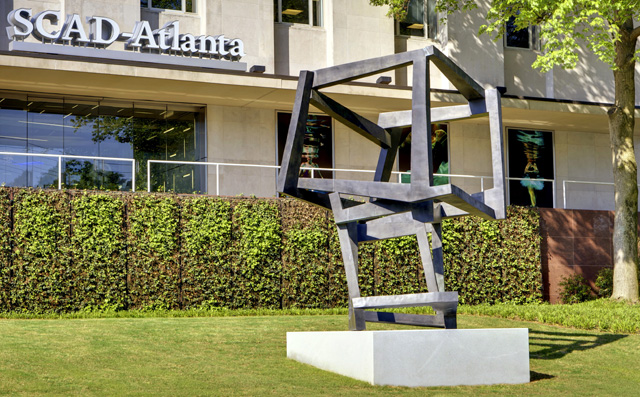
Jedd Novatt. Chaos Mundaka, 2009. Bronze. SCAD-Atlanta, Atlanta, Georgia.
VS: You have talked about one work leading to another, but when you are finishing the work, what are the qualities you are looking for that tell you it is finished?
JN: I end up experiencing the work as a whole. I look for that. Yet, all the passages that lead to that whole have to work. So, to continue the musical analogy, with the idea of passages leading to an overall work, I think it’s the same. There are passages, but when you focus on the passage, it has to succeed just as much as the whole. Where you see the work from a distance, it works for you. You get up close and it works because the passages work. And, again, they become the language of the work, the words of the work. The passages are the words of the work. That part of it I like.
I’ve been working almost 40 years. I feel the same tension about the next work as I did 40 years ago or 30 years ago - the same tension of wanting to achieve something that I’m looking for. And knowing that I may or may not get there. What is it about our species that wants to make things and has made things for thousands and thousands of years? I don’t have the answer.
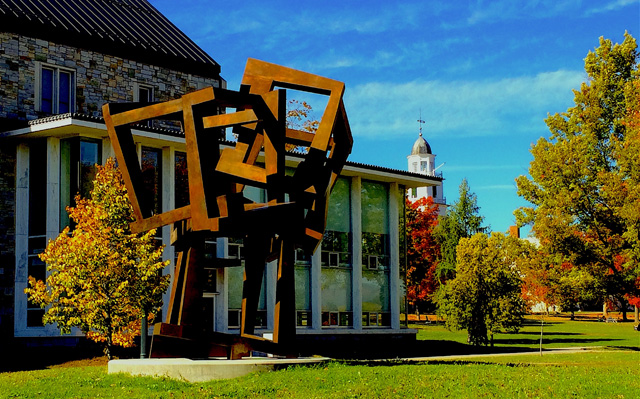
Jedd Novatt. Chaos XAXIS, 2012. Bronze, 2012, 457 x 427 x 285 cm. Middlebury Museum of Art, 2015.
In the end, are we making work for ourselves today, not ourselves as artists, but for ourselves historically? Or do we recognise that we’re just making stuff. It might exist now, it may get destroyed.
For me, obviously, there’s a certain element that it’s fabulous the artworks existed at all to begin with. How long they exist, that’s a trickier thing. I’ve no idea. You asked earlier why I work in steel. Maybe part of the attraction of steel is the recognition that it’s pretty damn hard to destroy. So maybe there’s some element of that in it.
VS: Is it a statement against the ephemerality of our existence?
JN: Yeah, it’s like this one you’re not going to blow down so easily!